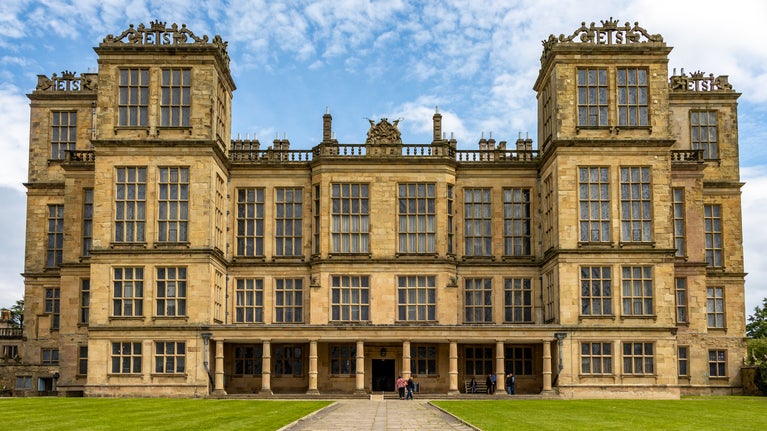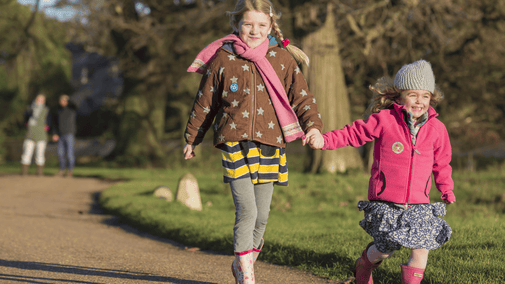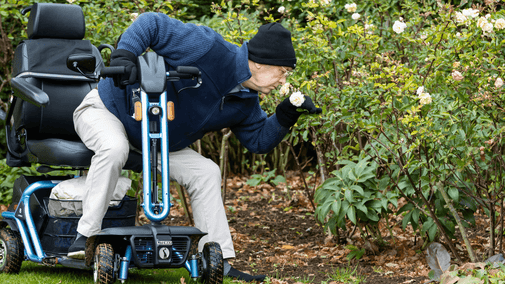
Hardwick's collections
Explore the objects and works of art we care for at Hardwick on the National Trust Collections website.

Hardwick Hall is the culmination of the personal taste and ambition of Elizabeth, Countess of Shrewsbury (1527–1608), fondly known as Bess of Hardwick.
In the late 16th century, Bess worked with Robert Smythson, mason and designer, to develop a unique building that suited the needs of an elite household. Subsequent generations have recognised the importance of Bess as a leading figure of Elizabethan society. Through ongoing conservation and care, her descendants have ensured the survival of this rare Elizabethan masterpiece and the collections inside.
Hardwick, meaning ‘herd farm’ or ‘sheep farm’, was first used in 1257 to name the estate where the Hall now stands. The land had been granted to Jocelin of Stainsby (also known as Jocelin de Haremere), by Robert Savage, Lord of the Manor of Stainsby, in 1253. Jocelin then passed the estate on to his son, who dropped the name ‘de Haremere’ entirely and became known as William ‘of Hardwick’ or ‘of Stainsby’. The land seems to have passed down through various family members until it finally reached Bess’s father, John Hardwick.
Bess was born on the Hardwick estate in about 1527 to the Hardwick family who were gentleman farmers. They lived in a small manor house, on the site where the Old Hall is now situated. As a child, Bess went in service as an upper servant in the London household of Sir John Zouche, a local Derbyshire family. Here she would have learnt how to dance, sew and play music.
In about 1543, whilst a teenager of 15 or 16, Bess married her cousin Robert Barlow (d. 1544). His family was slightly more prosperous than the Hardwicks. Robert died only a few months after they were married, and she was left with a widow’s income.
Bess was now an eligible young widow. In 1547 she married William Cavendish (1501–1557) – an older, extremely rich government servant. Together they had eight children, with three sons and three daughters surviving to adulthood. William Cavendish died in 1557, leaving Bess a large proportion of his property. This included Chatsworth, where she lived whilst not at court in London.
In 1559, Bess married Sir William St Loe (1519–1565), whom she probably met at the court of Elizabeth I. He was from a well-established family and held important titles. As a wedding gift the Queen made Bess a Lady of the Privy Chamber, which was part of Elizabeth’s inner circle. She now had the ear of the most important and powerful woman in the country. When William died in 1564–5, he left most of his property to Bess, much to his family’s annoyance.
Her final marriage was in 1567 to George Talbot, 6th Earl of Shrewsbury (c. 1522/28–1590), head of one of the richest families in England. Also at this time, Bess’s youngest daughter, Mary, married George’s second son, Gilbert, and Bess’s eldest son, Henry, married George’s daughter, Grace.
The Shrewsburys spent many years guarding Mary, Queen of Scots, which put a big strain on their marriage as well as their finances. Their relationship ultimately soured, ending quite abruptly when George took armed guards to remove Bess from Chatsworth.

In 1584, following the breakdown of her marriage to George, Earl of Shrewsbury, Bess moved out of Chatsworth and back to her childhood home at Hardwick. She had bought it from her brother, James, in 1583. She began to extend the modest manor house into a more suitable home for her and her family, which later became known as the Old Hall.
In 1590, when the Earl of Shrewsbury died, Bess’s inheritance enabled her to start a new building project – the New Hall, known simply as Hardwick Hall today. She continued extending the Old Hall with both projects running alongside each other for many years.
Robert Smythson, working under the experienced eye of Bess, designed and built Hardwick Hall, basing it on the plan of an Italian villa. The result was a symmetrical Elizabethan prodigy house, designed to be fit for a Royal visit. It was positioned in a dominant location overlooking the surrounding landscape so it could be seen from afar. Its vast expanse of glass led Robert Cecil, 1st Earl of Salisbury, to comment: ‘Hardwick Hall? More window than wall’.
In 1601, Bess commissioned an inventory of all her belongings for her Will. As a result, we know exactly what was in each room at that moment in time. Many original items still remain in the house, such as the Seadog Table, Gideon tapestries and the portrait of Elizabeth I.
Lady Arbella Stuart (1575–1615) was Bess’s granddaughter, the only child of her second daughter, Elizabeth, who had been hastily married to Charles Stuart, Earl of Lennox in 1574. This meant that Arbella was an heir to the throne and potentially a threat to Elizabeth I’s rule.
Arbella’s father died when she was one year old; her mother died a few years later. At the age of 6, Arbella was left in the care of her grandmother Bess and later lived with her at Hardwick Hall.
Following an unsanctioned secret marriage to William Seymour on 22 June 1610, Arbella was put under house arrest at Hardwick Hall and later in the Tower of London. She remained there for a few years, until her mental health declined and she starved herself to death.

Following Bess’s death in 1608, her favourite son, William Cavendish, 1st Earl of Devonshire (1551–1626) took over the running of Hardwick, and other properties. He added to this empire in 1610 when he bought Chatsworth from his older brother, Henry. He was a wealthy man, having made considerable investments in the East India Company and the Russia Company. He was also an early investor in the English colonisation of Virginia. James I gave him the title Baron Cavendish, and William later paid £10,000 to be made Earl of Devonshire. His wealth and status ensured that he met royal approval, with a visit to Hardwick by Charles I in 1619.
William was succeeded by his son, also William, 2nd Earl of Devonshire (1590–1628), upon his death in 1626. He married Christian Bruce (1595–1675), the daughter of Scottish Lord Kinloss. A close friend of James I, he built up large debts from high-living at court. Dying in 1628, he left Christian a widow with three young children and debts of £38,000. Through good judgement and business acumen, she was able to save the family fortunes for her eldest son, William, 3rd Earl of Devonshire.
William Cavendish, 3rd Earl of Devonshire (1617–84) supported the King in the first Civil War, remaining in France from 1642–5. Married to Elizabeth Cecil (1619–89), he was succeeded by his son, William, the 4th Earl and later 1st Duke of Devonshire.
William Cavendish, 4th Earl and 1st Duke of Devonshire (1640–1707), was politically active, well-travelled and well-educated. He was one of seven signatories inviting William of Orange to take rule in England during the ‘Glorious Revolution’ and was rewarded with a Dukedom in 1696. He made Chatsworth his main home, rebuilding Bess’s Elizabethan building into a fashionable home.
Following the decision of the 1st Duke to move the family seat to Chatsworth, Hardwick was used intermittently, with the 2nd, 3rd and 4th Dukes visiting infrequently. The 4th Duke pulled down some of the Old Hall, creating a picturesque ruin that attracted visitors looking to the ‘romantic’ past.
When the 5th Duke, William Cavendish (1748–1811) married Georgiana Devonshire (née Spencer), Duchess of Devonshire (1757–1806), Hardwick came back into favour. The couple visited more often and made the house habitable again. Architect John Carr was employed to make some changes in the Hall, which included significantly lowering the ceiling in the State Withdrawing Room to provide additional staff accommodation in the attics.
William George Spencer Cavendish, 6th Duke of Devonshire (1790–1858) succeeded his father in 1811. As was the family tradition, he was a Whig politician. He campaigned for Catholic emancipation in Ireland, the abolition of slavery and the Great Reform Bill. Known as the ‘Batchelor Duke’, William loved Chatsworth, but he also took a particular interest in Hardwick. He celebrated the history of the house, rather than modernising it. He carried out repairs and relocated older collection items from his other houses to Hardwick, including the Mortlake tapestries on the main stairs and paintings on top of the Gideon tapestries in the Long Gallery, a display started by his father.
As the 6th Duke died without a direct heir, the Dukedom was inherited by his cousin, William Cavendish (1808–91). The 7th Duke was married to Blanche Howard (1812–40), the daughter of the 6th Duke’s sister, Georgiana. Blanche died young, and it was their daughter, Lady Louisa Egerton (1835–1907) that supported her father in repairs and interior changes to the hall.
The 7th Duke's son, Spencer Compton Cavendish, 8th Duke of Devonshire (1833–1908) and Secretary of State for India, inherited the title in 1891 but died childless having changed little at Hardwick.

Victor Christian William Cavendish, 9th Duke of Devonshire (1868–1938), nephew of the 8th Duke, and Secretary of State for the Colonies, inherited the title in 1908. However, it was his wife Duchess Evelyn (1870–1960), who had the most impact on Hardwick through her care and conservation of the textile collection. She installed electric lighting in 1938–9 and reintroduced rush matting to the State Rooms on the second floor. The Duke’s health was severely affected following a stroke in 1925, dramatically changing his personality. Evelyn managed his affairs until his death in 1938, when she made Hardwick her permanent home. Their son inherited to become Edward Cavendish, the 10th Duke of Devonshire (1895–1950).
In 1940, after the outbreak of the Second World War, the 10th Duke, suggested the park should be given over to the military. The first Parachute Regiment training camp was consequently based on the estate at Hardwick and an entire army village and battle school was built above the ponds.
After the war, the battle school and village were turned into a Polish resettlement camp for allied soldiers. Here Polish veterans, and later Hungarian refugees, were temporarily housed. Many later settled in the local area.

Despite his best efforts, the Devonshire estates were left with a large tax bill when the 10th Duke died. His eldest son, William had been killed in action in Belgium in 1944 and so it was his younger brother, Andrew (1920–2004), who inherited the Dukedom, along with a colossal tax burden. In 1956, after much discussion, Andrew, the 11th Duke, decided to give Hardwick Hall to the National Trust in lieu of death duties, together with agricultural land. In 1958 the transfer was made and in 1959 Hardwick opened its doors under the care of the National Trust.
Over the last 65 years the National Trust has continued to develop the visitor offer at Hardwick Hall, alongside ongoing building maintenance work and collections care.
Current projects include the conservation of the 16th-century tapestry, ‘The Discovery of Achilles by Ulysses’, from a set of eight that hang in the High Great Chamber, and the conservation of 14 paintings closely associated with Bess and her family, including the recently purchased ‘Gilbert Talbot, 7th Earl of Shrewsbury’, dated 1596.
In 2024, Hardwick Hall proudly received the Europa Nostra Award for the conservation of the Gideon tapestries, a 24-year project that saw 13 huge tapestries brought back to their former glory.

Explore the objects and works of art we care for at Hardwick on the National Trust Collections website.
There's plenty for families to do at Hardwick Hall, including seasonal trails, adventuring in the parkland and exploring the house. Find out what's on and plan your visit.

Enjoy serenity in the garden at Hardwick Hall this winter, find the first snowdrop of the season or get outdoors for a breath of fresh air.

After 24 years of conservation, the 13th and final Gideon tapestry has returned to Hardwick Hall, marking the end of the National Trust's longest ever conservation project.
Learn about people from the past, discover remarkable works of art and brush up on your knowledge of architecture and gardens.
